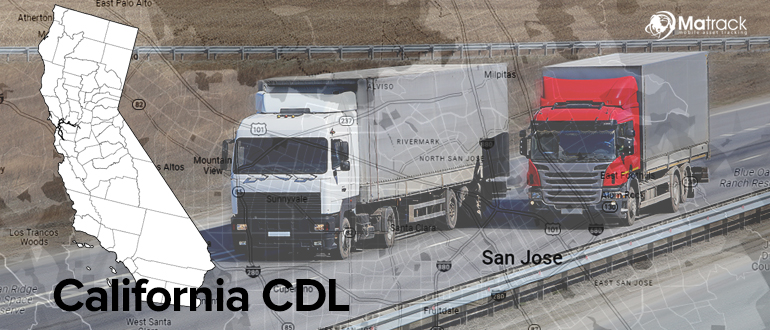Key Takeaways
- A California CDL is required for commercial vehicles, with Class A for trucks, Class B for buses, and Class C for passenger or hazardous transport.
- Getting a CDL requires meeting age, residency, medical, and testing requirements, including passing knowledge and skills tests.
- CDL training costs range from $1,500 to $7,000, with private schools, community colleges, and company-sponsored programs.
- To keep a CDL, drivers must follow safety laws, avoid violations, and renew their license and medical certification on time.
Commercial Driver’s License (CDL) is mandatory in California for individuals operating large commercial vehicles such as trucks, buses, and hazardous material carriers. To obtain a CDL, applicants must meet specific requirements, pass knowledge and skills tests, and complete necessary training programs.
This guide covers CDL types (Class A, B, and C), application steps, costs, training, and job outlook to help you navigate the CDL process in California.
What is a CDL in California?
A Commercial Driver’s License (CDL) is issued by the California Department of Motor Vehicles (DMV) and is required for drivers operating commercial motor vehicles (CMVs) that meet certain weight or passenger capacity thresholds.
A CDL is divided into three main classes based on the type of vehicle a driver will operate:
- Class A CDL – Heavy combination vehicles (e.g., tractor-trailers).
- Class B CDL – Large single vehicles (e.g., buses, box trucks).
- Class C CDL – Specialty vehicles (e.g., hazmat trucks, small passenger transport).
Each CDL class has different requirements and endorsements depending on the driver’s intended job.
California CDL Requirements
To qualify for a California CDL, applicants must meet specific criteria based on age, residency, medical fitness, and testing requirements.
Age Requirements:
- 18 years or older for intrastate (California-only) driving.
- 21 years or older for interstate (out-of-state) driving and hazardous material transport.
Residency and Identification:
- Must be a California resident.
- Provide proof of identity (e.g., California driver’s license, passport, or green card).
Medical Examination:
- Pass a DOT physical exam from an FMCSA-approved medical examiner.
- Submit a Medical Examiner’s Certificate (MCSA-5876).
- Must have 20/40 vision in each eye (with or without corrective lenses).
Testing Requirements:
- Pass the CDL knowledge test for the desired class.
- Obtain a Commercial Learner’s Permit (CLP).
- Complete behind-the-wheel training and pass the skills test.
California CDL Classes and Vehicle Types
California offers three CDL classes based on the weight and function of the vehicle a driver will operate.
What is a Class A License in California?
A Class A CDL is required for operating combination vehicles with a Gross Combination Weight Rating (GCWR) of 26,001 pounds or more, towing trailers over 10,000 pounds.
Vehicles that Require a Class A CDL:
- Tractor-trailers (semi-trucks, 18-wheelers).
- Truck and trailer combinations (e.g., livestock carriers).
- Tanker trucks (transporting liquid cargo).
- Flatbeds and dump trucks with trailers.
Endorsements for Class A CDL:
- T – Double/triple trailers.
- N – Tank vehicles.
- H – Hazardous materials.
- X – Tanker + hazardous materials.
What is a Class B License in California?
A Class B CDL is required for operating single vehicles with a Gross Vehicle Weight Rating (GVWR) of 26,001 pounds or more, without a trailer over 10,000 pounds.
Vehicles that Require a Class B CDL:
- Straight trucks (box trucks, large delivery trucks).
- City transit and tour buses.
- School buses and shuttle buses.
- Cement mixers and garbage trucks.
Endorsements for Class B CDL:
- P – Passenger transport (buses).
- S – School bus operations.
- H – Hazardous materials (if applicable).
What is a Class C License in California?
A Class C CDL is required for smaller commercial vehicles that do not meet the weight requirements of Class A or B but transport passengers or hazardous materials.
Vehicles that Require a Class C CDL:
- Passenger vans carrying 16 or more passengers.
- Hazardous materials transport vehicles requiring placards.
- Small box trucks (if used commercially with hazardous materials).
Endorsements for Class C CDL:
- P – Passenger transport.
- H – Hazardous materials.
- X – Combination of tanker and hazardous materials.
California CDL Costs
Getting a CDL in California involves various fees, including application, training, testing, and endorsements.
CDL Application and Testing Fees
- CDL Application Fee – $85
- Commercial Learner’s Permit (CLP) – Included in application
- Knowledge Test Retake – $10 per attempt
- Road Skills Test Fee – Varies (often included in training)
CDL Training Costs
Training is highly recommended to pass the skills test. Costs vary depending on the school and program length.
- Private CDL Schools – $3,000 to $7,000
- Community Colleges – $1,500 to $3,000
- Company-Sponsored Training – Often free with work commitment
Additional Fees
- DOT Physical Exam – $50 to $200
- HazMat Background Check – $86.50
- Endorsement Fees – $40+ per endorsement
CDL Training in California
Completing formal training increases passing rates and job readiness.
Types of CDL Training Programs
- Private Truck Driving Schools – Short, intensive programs with hands-on training.
- Community Colleges – Lower-cost CDL training with flexible schedules.
- Company-Sponsored Programs – Some companies pay for CDL training in exchange for a work commitment.
Training Curriculum
- Classroom Training – CDL laws, FMCSA regulations, logbooks.
- Behind-the-Wheel Training – Pre-trip inspections, shifting, maneuvering.
- Road Test Preparation – Mastering CDL exam requirements.
California CDL Endorsements – A Detailed Breakdown
Endorsements allow CDL holders to operate specialized vehicles. This section can be more detailed by explaining why each endorsement is important and what is required to obtain them.
| Endorsement | Description | Test Required? | Additional Requirements |
| H – Hazardous Materials (HazMat) | Allows transport of hazardous materials like chemicals, gases, and explosives. | Yes | TSA background check + fingerprinting |
| N – Tank Vehicles | Required for vehicles carrying liquid or gaseous materials in tanks. | Yes | No additional background check |
| X – Combination of Tanker & HazMat | Required for tanker trucks carrying hazardous materials. | Yes | Combination of HazMat & Tanker requirements |
| P – Passenger Transport | Required to transport 16+ passengers (e.g., buses, shuttles). | Yes | Skills test with a passenger vehicle |
| S – School Bus | Allows drivers to operate school buses. | Yes | Additional school bus safety training |
| T – Double/Triple Trailers | Required for drivers towing two or more trailers. | Yes | Knowledge test only |
How to Choose the Best Program
We can expand this section by explaining how to select a high-quality CDL school, what to look for in a training program, and the pros and cons of different options.
Private Truck Driving Schools
✅ Pros:
- Fast-tracked programs (4-8 weeks).
- Job placement assistance.
- Dedicated hands-on training.
❌ Cons:
- Expensive ($3,000 to $7,000).
- Some programs lack financial aid.
Community College CDL Training
✅ Pros:
- More affordable ($1,500 to $3,000).
- Accredited programs.
❌ Cons:
- Takes longer (8-12 weeks).
- Limited spots available.
Company-Sponsored CDL Training
✅ Pros:
- Free or low-cost tuition.
- Guaranteed job placement.
❌ Cons:
- Work commitment required (usually 1 year).
- Less flexibility in choosing employers.
Tip: Look for CDL schools that are FMCSA-approved and have high pass rates on the CDL skills test.
CDL Job Market in California – Where to Find the Best Opportunities
Instead of just listing salaries, we can break down high-paying industries and explain where CDL holders can find the best jobs.
Highest-Paying CDL Jobs in California
| Industry | Average Salary | Best Locations |
| Long-Haul Trucking (OTR) | $65,000 – $90,000 | Los Angeles, Bakersfield, Sacramento |
| Local Delivery (LTL) | $50,000 – $70,000 | San Diego, San Francisco, Riverside |
| HazMat Transport | $75,000 – $100,000 | Refinery regions (Bay Area, Los Angeles) |
| Public Transit (Buses) | $55,000 – $75,000 | San Francisco, Los Angeles, San Jose |
| Construction Trucking | $60,000 – $85,000 | Fresno, Stockton, Sacramento |
How to Find CDL Jobs in California
- Check job boards like Indeed, CDLjobs.com, and trucking company websites.
- Apply at large trucking firms (Swift, Schneider, JB Hunt).
- Consider union jobs for better benefits (Teamsters).
How to Apply for a California CDL (Expanded)
Applying for a California CDL requires several steps, and visiting the California DMV website is essential for up-to-date information, scheduling tests, and completing online forms.
Step 1: Visit the California DMV Website
- Go to the official website.
- Check the latest CDL application process, required documents, and fees.
- Download the Commercial Driver Handbook for test preparation.
- Schedule the knowledge test appointment online.
Step 2: Obtain a Commercial Learner’s Permit (CLP)
- Meet age (18 or 21) and residency requirements.
- Submit a CDL application at a local DMV office.
- Provide a valid California driver’s license, SSN, and proof of residency.
- Pass the CDL knowledge test and obtain a CLP.
- Hold the CLP for at least 14 days before scheduling the skills test.
Step 3: Complete CDL Training
- Enroll in a state-approved CDL training school.
- Receive hands-on driving experience in a vehicle matching your CDL class.
- Gain experience in pre-trip inspections, basic maneuvers, and road safety.
Step 4: Schedule and Pass the CDL Skills Test
- Visit the California DMV website to schedule the skills test.
- Take the pre-trip inspection, basic control, and on-road driving test at a DMV-approved test site.
Step 5: Receive Your CDL
- After passing the test, pay the required CDL licensing fee.
- Receive your California CDL in the mail.
CDL Violations and How to Avoid Disqualification
CDL drivers face stricter penalties than regular drivers. Adding real-world examples helps reinforce the importance of safe driving.
CDL Disqualifications and Penalties
| Violation | Consequence |
| DUI (BAC 0.04% or higher) | 1-year CDL suspension |
| Speeding 15+ mph over limit | Heavy fines, possible suspension |
| Leaving the scene of an accident | Lifetime CDL revocation |
| Driving without a valid CDL | Fines up to $5,000 |
| Railroad crossing violations | 60-day suspension |
Ways to Avoid CDL Disqualification
- No Alcohol or Drugs – BAC over 0.04% leads to a 1-year suspension.
- Follow Speed Limits – Speeding 15+ mph over can suspend your CDL for 60 days.
- Keep CDL & Medical Certificate Updated – Expired documents can invalidate your license.
- Follow Driving Hour Limits – Max 11 hours per day, 70 hours per 8 days.
- Inspect Your Truck Daily – Check brakes, tires, lights, and leaks before driving.
- No Phone Use While Driving – Hands-free only; texting can lead to fines and suspension.
- Report All Accidents – Leaving the scene results in lifetime CDL revocation.
Conclusion
California CDL is essential for those pursuing a career in commercial driving. Class A, B, and C licenses determine the type of vehicles you can operate. With training costs between $1,500 and $7,000, the investment can lead to high-paying and in-demand job opportunities.
If you’re ready to start your CDL journey, research training programs, costs, and job openings to make an informed decision.






